 Facebook
Facebook
 X
X
 Instagram
Instagram
 TikTok
TikTok
 Youtube
Youtube
The art and science of hanging pictures has been much neglected. Everybody knows how to hang pictures, so there can't be anything to it, runs the popular wisdom. Many a real estate agent, stuck with apartments having craters all Over the walls where tenants put up their art collections and memorabilia wishes the popular wisdom would be dispelled:
Have you ever tried to pound a nail into a flower pot? Obviously, it would never work. The flower pot would shatter. But everybody pounds nails into plaster, which has very little reason to work any better. If plaster docs not actually shatter When a nail is Pounded into it, it is at least weakened. so that any weight applied to a nail in it will soon complete the disintegration.
But there are mounting devices more satisfactory than nails, and no reason to hesitate to put up any. thing on any wall. To which end is provided this list of wall-hanging devices-which covers the range of applications from hanging a one-pound plaque on wood to hanging a suit of armor on brick.
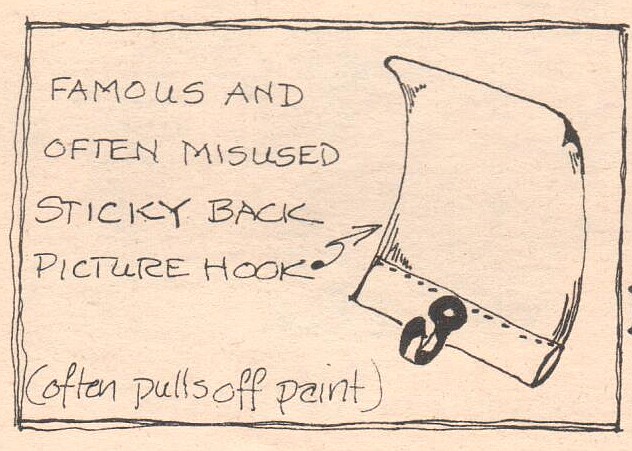
Sticky-backed picture hooks are satisfactory for hanging very small items. weighing a pound or less They have the unfortunate drawback of pulling off the paint if they are removed.
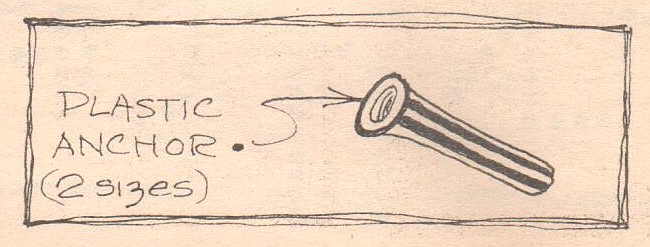
Plastic anchors are used to make possible screwing light-weight items into plaster Or plasterboard. They Come in two sizes, One for screws No. 10 and under, and one for screws No. 10 and over. To use a plastic anchor. you will need a drill, which is used to excavate a hole for the anchor. The size of drill to be used is specified on the package of anchors. Once the hole has been drilled, the anchor is inserted, and a screw is driven into the anchor, causing it to expand and hold firmly in the wall. Since drills can be rented from your local hardware store for as little as $1 a day this is not a difficult process and is far more satisfactory than a nail or bulldog hook in plasterboard. Screws with plastic anchors can often be used for lightweight shelf-bracket supports as well, but are not the best choice if the shelf is to support heavy books.
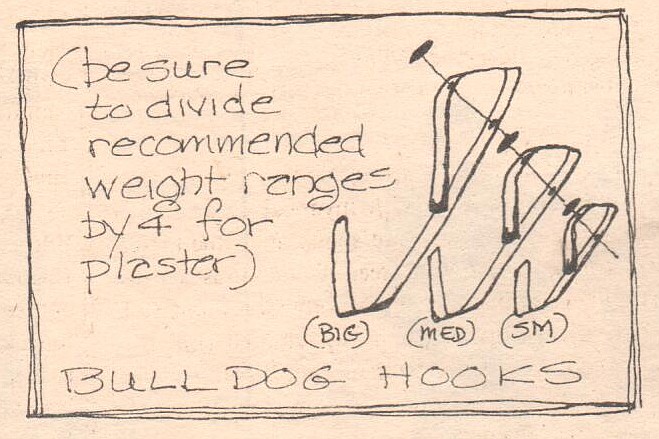
Bulldog Hooks are ideal for hanging things in wood.
They come in varying sizes, suggested for particular weight-ranges. These weight ranges are for hanging in wood, however: If you use a bulldog hook in plaster, plasterboard, or wall-board, divide the suggested weight by four. And never, no matter what the package claims, should you try to hang an item weighing more than 25 pounds in plaster using a bulldog hook.
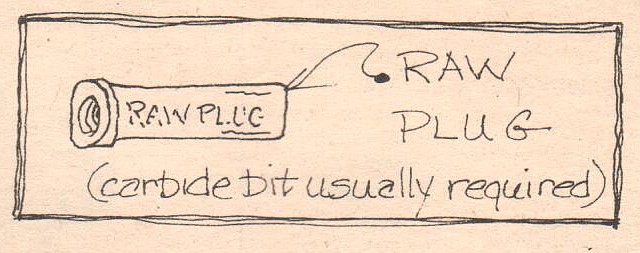
Raw plugs are useful if you have a stronger wall — one made of a concrete-plaster combination, or of masonry. Here again, the process is to drill a hole, and insert the plug-which is made of metal sheathed in fibers. The difficulty is that to drill in these harder materials you will have to have a low·speed drill and a carbide bit. Other drills would overheat. Concrete-plaster walls are often found in high-rise modern apartments.
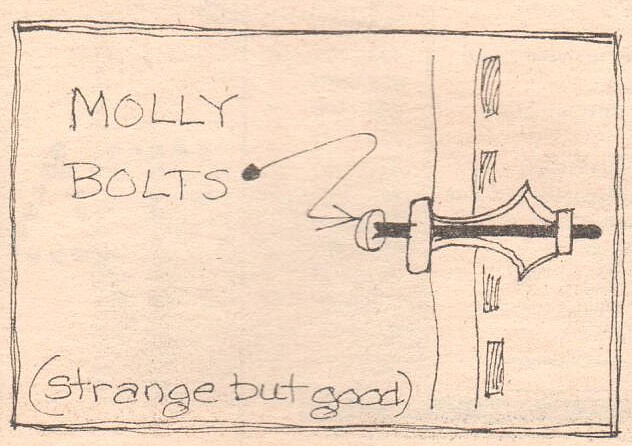
Molly-bolts or expanding screws, are the most unusual looking hardware in the lot. They take advantage of the fact that shortly behind most plaster Or plasterboard is an empty space, and they actually clamp onto the back part of the wall, thus distributing the weight over a larger area. The first step in using a molly-bolt is to drill a hole entirely through the plaster or plasterboard. Then the molly-bolt is inserted, and tightened, which draws the collar up against the back of the wallboard or plaster. Once it has been tightened, the base is permanently in the wall and the bolt can be removed Without disturbing it. This is an advantage Over the spring-wing, or shelf-support, or towel rack — need not be in position at the time the molly-bolt is installed. Because of their design, molly-bolts can be most successfully used in wallboard or plasterboard; sometimes with plaster, the lath in back will interfere with the proper setting of the bolt.
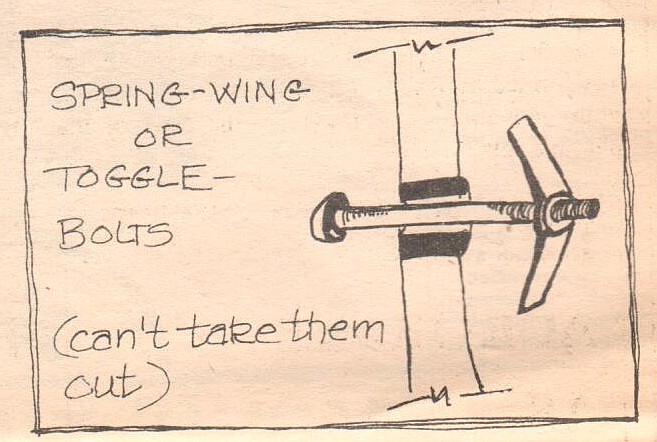
Spnng-wings or toggle-bolts serve the same purpose as molly-bolts: they distribute the weight of the, object being hung over the back of the wall. Often they come with longer bolts, which makes them better for thicker walls. To use a spring-wing, you must again drill a hole, only this lime it must be large enough to accommodate the entire wing in its folded position. This can be a problem, since common household drills ordinarily have bits ranging in size up to a quarter of an inch, and a typical 1/8" diameter bolt would require a 3/8" hole. Once the hole has been drilled, the spring-wing must be taken apart and whatever is to be fastened with the bolt must be Put onto it, since the bolt can be tightened only once. If you do not plan to use a large item on the front 'of the wall, such as a shelf-bracket. washers amy be required. If an object requires several spring-wings to mount, all the holes must be drilled first, and all of the spring-wings must be inserted in the same operation, since there is no way to take them in or out.
Lag Shields, Ackerman-Johnsons, or Calkins are used in concreted or masonry for very heavy mounting. Cast-iron is often mounted using these. If you are ambitious enough to tackle a task of this nature, you should probably know more that can be told here.
In some very modern buildings, there is so little space between walls that toggle-bolts cannot be used. Recently, I was drilling in a townhouse, and to my dismay, the drill went through very quickly and into a room in the next apartment, startling the residents here. The only thing to do in the case of such inferior construction is to substitute a molly-bolt for the toggle-bolt, or try cutting the latter off.

The art and science of hanging pictures has been much neglected. Everybody knows how to hang pictures, so there can't be anything to it, runs the popular wisdom. Many a real estate agent, stuck with apartments having craters all Over the walls where tenants put up their art collections and memorabilia wishes the popular wisdom would be dispelled:
Have you ever tried to pound a nail into a flower pot? Obviously, it would never work. The flower pot would shatter. But everybody pounds nails into plaster, which has very little reason to work any better. If plaster docs not actually shatter When a nail is Pounded into it, it is at least weakened. so that any weight applied to a nail in it will soon complete the disintegration.
But there are mounting devices more satisfactory than nails, and no reason to hesitate to put up any. thing on any wall. To which end is provided this list of wall-hanging devices-which covers the range of applications from hanging a one-pound plaque on wood to hanging a suit of armor on brick.

Sticky-backed picture hooks are satisfactory for hanging very small items. weighing a pound or less They have the unfortunate drawback of pulling off the paint if they are removed.

Plastic anchors are used to make possible screwing light-weight items into plaster Or plasterboard. They Come in two sizes, One for screws No. 10 and under, and one for screws No. 10 and over. To use a plastic anchor. you will need a drill, which is used to excavate a hole for the anchor. The size of drill to be used is specified on the package of anchors. Once the hole has been drilled, the anchor is inserted, and a screw is driven into the anchor, causing it to expand and hold firmly in the wall. Since drills can be rented from your local hardware store for as little as $1 a day this is not a difficult process and is far more satisfactory than a nail or bulldog hook in plasterboard. Screws with plastic anchors can often be used for lightweight shelf-bracket supports as well, but are not the best choice if the shelf is to support heavy books.

Bulldog Hooks are ideal for hanging things in wood.
They come in varying sizes, suggested for particular weight-ranges. These weight ranges are for hanging in wood, however: If you use a bulldog hook in plaster, plasterboard, or wall-board, divide the suggested weight by four. And never, no matter what the package claims, should you try to hang an item weighing more than 25 pounds in plaster using a bulldog hook.

Raw plugs are useful if you have a stronger wall — one made of a concrete-plaster combination, or of masonry. Here again, the process is to drill a hole, and insert the plug-which is made of metal sheathed in fibers. The difficulty is that to drill in these harder materials you will have to have a low·speed drill and a carbide bit. Other drills would overheat. Concrete-plaster walls are often found in high-rise modern apartments.

Molly-bolts or expanding screws, are the most unusual looking hardware in the lot. They take advantage of the fact that shortly behind most plaster Or plasterboard is an empty space, and they actually clamp onto the back part of the wall, thus distributing the weight over a larger area. The first step in using a molly-bolt is to drill a hole entirely through the plaster or plasterboard. Then the molly-bolt is inserted, and tightened, which draws the collar up against the back of the wallboard or plaster. Once it has been tightened, the base is permanently in the wall and the bolt can be removed Without disturbing it. This is an advantage Over the spring-wing, or shelf-support, or towel rack — need not be in position at the time the molly-bolt is installed. Because of their design, molly-bolts can be most successfully used in wallboard or plasterboard; sometimes with plaster, the lath in back will interfere with the proper setting of the bolt.

Spnng-wings or toggle-bolts serve the same purpose as molly-bolts: they distribute the weight of the, object being hung over the back of the wall. Often they come with longer bolts, which makes them better for thicker walls. To use a spring-wing, you must again drill a hole, only this lime it must be large enough to accommodate the entire wing in its folded position. This can be a problem, since common household drills ordinarily have bits ranging in size up to a quarter of an inch, and a typical 1/8" diameter bolt would require a 3/8" hole. Once the hole has been drilled, the spring-wing must be taken apart and whatever is to be fastened with the bolt must be Put onto it, since the bolt can be tightened only once. If you do not plan to use a large item on the front 'of the wall, such as a shelf-bracket. washers amy be required. If an object requires several spring-wings to mount, all the holes must be drilled first, and all of the spring-wings must be inserted in the same operation, since there is no way to take them in or out.
Lag Shields, Ackerman-Johnsons, or Calkins are used in concreted or masonry for very heavy mounting. Cast-iron is often mounted using these. If you are ambitious enough to tackle a task of this nature, you should probably know more that can be told here.
In some very modern buildings, there is so little space between walls that toggle-bolts cannot be used. Recently, I was drilling in a townhouse, and to my dismay, the drill went through very quickly and into a room in the next apartment, startling the residents here. The only thing to do in the case of such inferior construction is to substitute a molly-bolt for the toggle-bolt, or try cutting the latter off.
Comments